|
Avicennia alba |
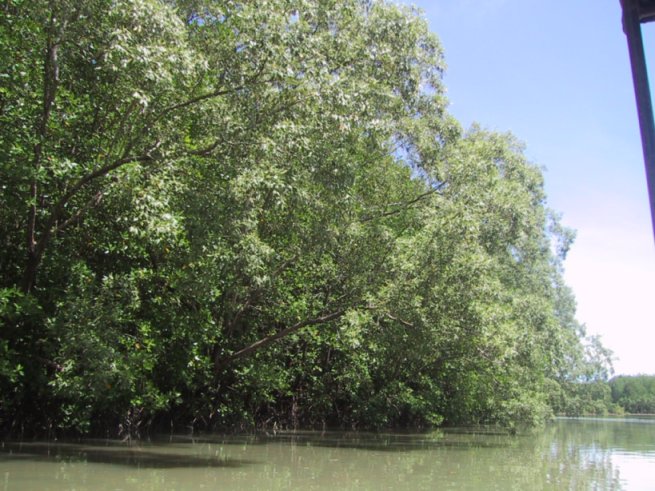  |
Tree up to 21 m in height. Pioneer species on new mudflats in estuarine conditions. Tree with dark or grey to black bark. Leaves elliptical with pointed tip; underside light almost whitish. Flowers yellow-orange in tight clusters. Fruit conical, pepper-like shape. Finger-like pneumatophores. |
|
Avicennia marina |
Tree up to 13 m in height. Found along sand flats able to tolerate high salinities. Tree bark mottled light brown to orange grey, irregular peeling reveals new green bark Leaves, often coated with salt, elliptical to ovate rounded tips, underside yellow-white with many tiny hairs. Flowers small orange yellow with short stamens. Fruit wider and fatter than A. alba. Finger-like pneumatophores. |
|
| Avicennia officinalis | 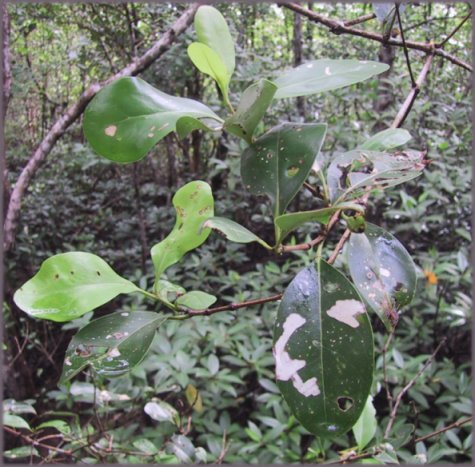 |
Tree up to 16 m in height. Found on soft mud in mid salinities. Tree with smooth, grey to dark brown bark. Leaves broadly elliptical with distinctive rounded tip. Underside greenish yellow, greener than other Avicennia species. Flowers orange yellow. Fruit ovoid to heart-shaped. Finger like pneumatophores. |
| Rhizophora apiculata (Red Mangrove) |
Tree up to 25 m in height usually much smaller. Found on soft muds in varying salinities. Tree with smooth dark bark which when exposed is red. Leaves with sharp dark green tips, underside is dark green with reddish rib. Flowers yellowish with thick outer petals. Fruit long thin and smooth. R. apiculata can be distinguished from R. mucronata by its smaller thinner leaves and by the red colouring when the bark is removed. Massive prop-roots. |
|
| Rhizophora mucronata | 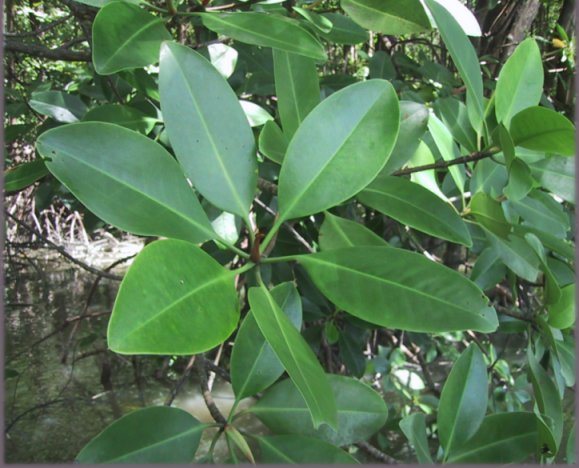 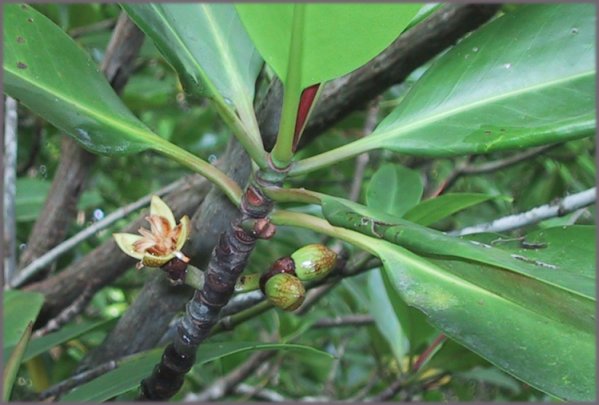 |
Trees up to 20 m (although large specimens are rare). Found in estuarine conditions with muddy or slightly firmer sediments. Tree bark may be scaled and when exposed is yellow–orange. Leaves large and oval, dark green in colour. Flowers similar to R. apiculata. Fruit massive long and warty. Forms extensive prop roots. |
| Ceriops tagal | 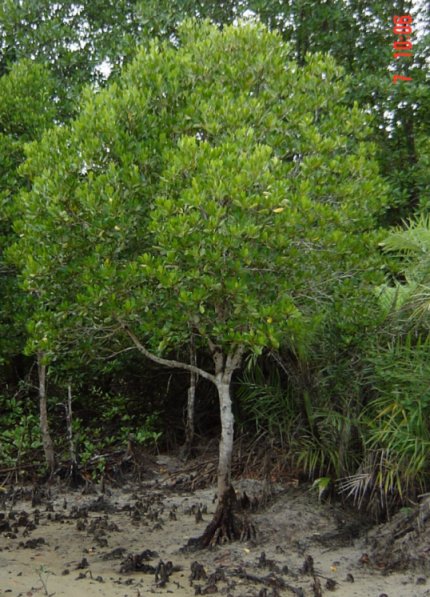 |
Tree up to 7 m in height. Found on the littoral fringe. Tree bark light. Leaves are yellow green with rounded tips. Flowers white in pairs with red anthers. Fruit slender warty and purple in colour when ripe. Roots buttresses and knee type. |
|
Ceriops decandra |
Tree up to 7 m in height. In upper mangrove areas in low salinities or freshwater boundary areas; on drier sediments. Tree bark is smooth and pale yellowish grey with patches of dark brown. Leaves shiny green upper surface, elongated with rounded tip. Flowers white clustered on short stalks. Fruit curved pointing upwards, ribbed and mainly green. Roots form buttresses. |
|
| Bruguiera cylindrical | Tree up to 18 m in height. Upper mangrove areas. Tree with grey bark. Leaves large elliptical Flowers white in small clusters. Fruit thin slightly grooved and curved, purple-green when mature. May produce buttress roots. |
|
| Bruguiera parviflora | 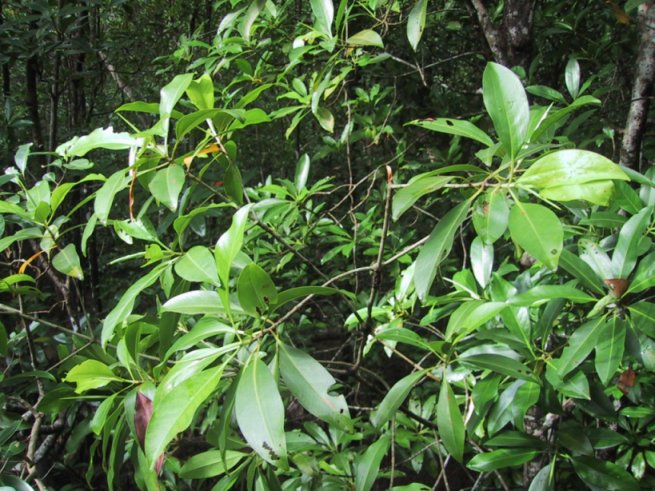 |
Trees up to 18 m in height. Found on firmer sediments on upper tidal levels of mid mangrove. Tree bark is smooth and grey to dark brown in colour. Leaves greenish yellow, large and elliptical. Flowers yellowish green and a calyx of 8 sepals. Fruit thin and small, purple brown with ripe. Flowers yellowish green and a calyx of 8 sepals. Fruit thin and small, purple brown with ripe. May develop buttress roots. |
|
Bruguiera gymnorhiza |
 |
Trees up to 18 m in height. Found in variable salinities in mid to upper mangroves. Tree bark dark grey, rough light coloured lenticels. Leaves large smooth and leathery elliptical with a poited tip; glossy green upper surface and reddish below. Flowers red with 14 prominent pointed calyx lobes. Fruit dark green with distinct red calyx ‘cap’. Roots pyramidal knee-roots. |
|
Xylocarpus granatum (The cannon ball mangrove tree) |
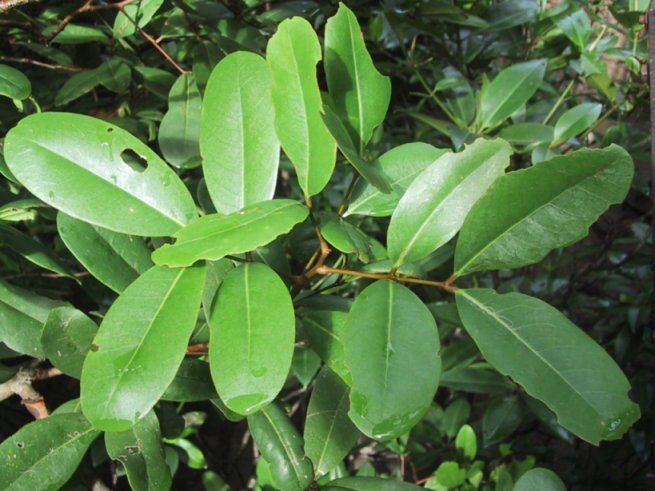 |
Trees up to 10 m in height. Found in low salinity and freshwater areas. Tree bark light coloured often with darker bark peeling away. Leaves large, oblong with rounded tip. Flower small white on irregular inflorescence. Fruit is distinctive large rounded, up to 2 kgs in weight. No pneumatophores. |
| Xylocarpus moluccensis | ||
|
Sonneratia alba |
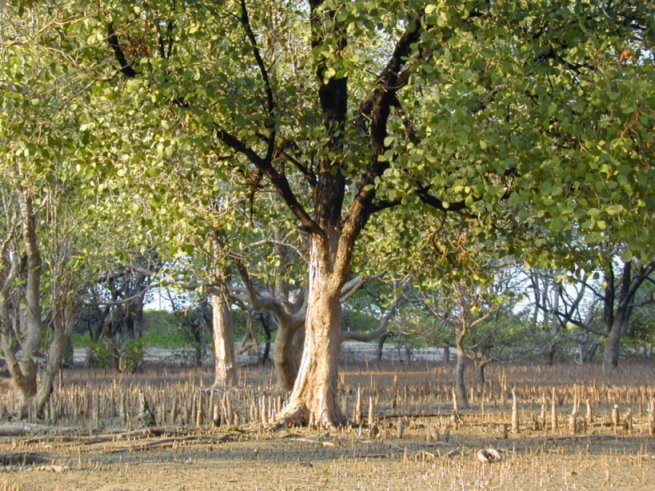 |
Trees up to 12 m in height. Pioneer species tolerant of high salinities, on sandy mud sediments. Tree with dark stems. Leaves slightly longer than broad, firm and fleshy, somewhat brittle. Young leaves may have a thorn like projection at the tip. Flowers large white flowers.. Fruit retain the calyx cap rounded with flat top. Large wide pneumatophores. |
|
Aegiceras corniculatum |
Shrub up to 3 m in height. Coloniser on newly deposited mud in a variety of salinities. Trees with smooth reddish bark. Leaves ovoid leathery notched at the tip. Colour light green, petiole red merging with a yellow or red midrib. Salt chrystals seen on upper leaf surface. Flower white organised into clusters on reddish stalks. Fruit is crescent shaped sharply pointed, green to reddish. |
|
|
Nypa fruticans (Mangrove palm) |
Found in back mangrove areas on soft mud in low salinities or nearly freshwater. Leaves are thick and palm-like with swollen bases. Fruit is large and spear-head shape, dark brown or reddish in colour. |
|
|
Phoenix paludosa |
Small palm found on hard muddy soils on margins of mangrove areas. Will grow in areas disturbed by thallasinid mounds. Leaves like Nypa but smaller and arranged at the crown of the plant. |
References
Akansornkoae, S., Maxwell, G. S., Havanond, S. & Panichsulo, S.1992. Plants in mangrove. Chongrat Co, Ltd, Bangkok. 120pp.
Snedaker, S. C. & Snedaker, J.G. (eds) 1984. The Mangrove ecosystem: research methods. UNESCO. 251pp.
Tomlinson, P.B. 1994. The biology of mangroves. Cambridge University Press. 419pp.

